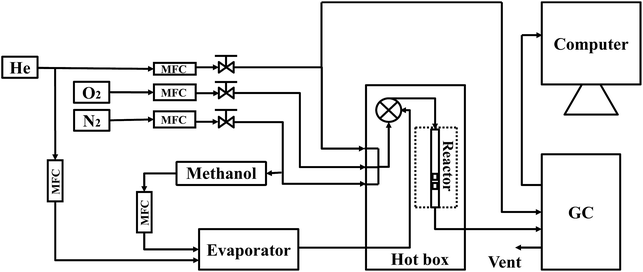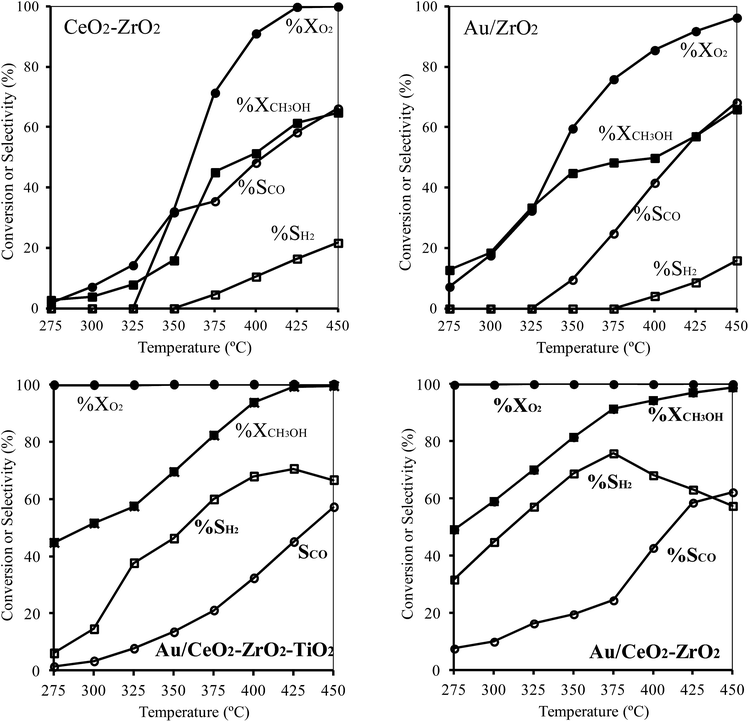Partial oxidation of methanol over Au/CeO2–ZrO2 and Au/CeO2–ZrO2–TiO2 catalysts†
Habibullah Bakea,
Sharif F. Zaman*ab,
Yahia A. Alhamedab,
Abdulrahim A. Al-Zahraniab,
Muhammad A. Daousab,
Sami Ullah Rathera,
Hafedh Drissb and
Lachezar A. Petrovb
aChemical and Materials Engineering Department, Faculty of Engineering, King Abdulaziz University, P. O. Box 80204, Jeddah 21589, Saudi Arabia. E-mail: zfsharif@gmail.com; sfzaman@kau.edu.sa; Tel: +966 563063594
bSABIC Chair of Catalysis, King Abdulaziz University, P. O. Box 80204, Jeddah 21589, Saudi Arabia
First published on 8th February 2016
Abstract
Experimental data on hydrogen production via a partial oxidation of methanol (POM) reaction on Au/ZrO2, Au/CeO2–ZrO2 and Au/CeO2–ZrO2–TiO2 catalysts is presented in this article. The gold catalysts were prepared by a deposition–precipitation (DP) method and characterized by XRF, XRD, H2-TPR, XPS methods N2 adsorption. The activity results show that the catalyst containing 1 wt% gold supported on a CeO2–ZrO2 carrier demonstrates very good hydrogen selectivity and the highest catalytic activity among all tested catalysts. The optimal working temperature established was 375 °C. At this temperature 75.5% hydrogen selectivity was registered. The presence of oxidized gold in the catalyst's composition as well as the support redox properties are the major factors controlling the observed catalytic activity.
Introduction
Partial oxidation of methanol (POM) is an exothermic reaction and does not need the addition of steam in the reaction mixture.1 It is thermodynamically favourable at mild reaction conditions. In contrast, methanol steam reforming is an endothermic reaction and needs additional in situ steam, which requires extra energy consumption.Gold-based catalysts are known for their superior activity for low-temperature CO oxidation, WGSR as well as number of organic compounds.2–5 Some of the published reports show that gold catalysts are also active for methanol partial oxidation demonstrating low selectivity towards CO formation and high selectivity towards hydrogen production.
For example, POM carried out in the presence of gold promoted copper–zinc oxide catalyst was reported to show 97% of hydrogen selectivity and 5.5% of CO selectivity at 190 °C.6
The oxidation activity of gold catalysts strongly depends upon the size of gold nanoparticles and on the ability of support to provide during the reaction the active oxygen species.7
Gold catalysts supported on reducible metal oxides are much more active in CO oxidation than the gold catalysts supported on non-reducible oxides, for example Au/TiO2 and Au/Fe2O3 are much more active than the Au/Al2O3.8
CeO2 has been successfully used by many researchers as a support for gold catalysts in different oxidation reactions, because it possesses several advantageous properties like high oxygen storage capacity, good redox properties, ability to release the storage oxygen during the reaction at low temperatures.9
ZrO2 is another attractive support material because of its stability at high temperatures and suitable mechanical and chemical properties. Researchers have proved that the addition of zirconia to the ceria leads to the formation of mixed oxides with increased thermal stability and optimal redox property compared to the single cerium or zirconium oxides.10,11 Mixed cerium–zirconium oxide supports forms smaller crystallites than the single oxides.
By supporting of both Au and Cu on CeO2–ZrO2 carriers catalysts for steam reforming of methanol with good catalytic activity and low CO selectivity at mild reaction temperatures has been prepared.10,12
In this work, results of studies of the catalytic properties of (mechanically mixed oxide CeO2–ZrO2, oxide systems) and gold containing catalysts Au/ZrO2, Au/(mechanical mixture of CeO2–ZrO2) and Au/(mechanical mixture of CeO2–ZrO2–TiO2) in POM reaction have been studied. An attempt for revealing the relation between the catalytic performance of the gold catalysts and their compositions and structures is proposed.
Experimental
Catalyst preparation
The deposition–precipitation of gold on mixed oxide supports was carried out in a Mettler Toledo Labmax reactor, which permits the precise control of the pH, temperature, liquid reagent delivery rates and mixing of the suspension. The CeO2–ZrO2–TiO2 and CeO2–ZrO2 supports were prepared by simple mechanical mixing of the components. The needed amounts of CeO2 (Acros Organics), ZrO2 (Aldrich Chemistry) and TiO2 (Sigma-Aldrich) were correctly measured and ultrasonically mixed for 1 h, then dried in the oven at 120 °C for 3 h prior to the gold deposition. In gold deposition experiments, the total gold loading was fixed at 1 wt%. A 0.1 M solution of KOH and de-ionized water were filled in the reactor to reach the pH = 12.7 at intensive mixing, and then the liquid was heated to 60 °C. After reaching the desired temperature and pH, heated to 60 °C support and exact amount of aqueous solution of HAuCl4·3H2O (Sigma-Aldrich) precursor were added to the reactor at intensive mixing. After that within 5 min pH was adjusted to 10.4 by addition of 0.5 M of HNO3, then pH was adjusted to 8 by the addition of 0.1 M of HNO3 in the next 5 min. Then the suspension was aged at 60 °C for 1 h at intensive mixing. The pH tuning was done by adding specified amounts of the Mg-citrate solution. Then the suspension was filtered and the obtained solid was washed with hot de-ionized water several times until chloride ions were totally removed. Removal of chloride ions was confirmed by addition of the drops of AgNO3 solution to the washing waters. Then the prepared catalytic mass was dried overnight at 100 °C and calcined at 500 °C for 5 h in air. After calcination the sample was pelletized, grounded and a fraction of particles size between 0.01–0.03 mm was separated. This fraction was used for further activity tests and catalyst characterizations.Catalytic activity measurements
The catalytic activity experiments were carried out in a (PID Eng & Tech, system, Spain) with a fixed bed quartz reactor (o.d. = 6 mm). The experimental setup is shown in Fig. 1. Experiments were carried out at atmospheric pressure and temperatures in the interval from 275 to 450 °C. The reactor was located in a temperature programmable furnace with a K type thermocouple placed in the centre of the catalyst bed. For each experiment, the reactor was charged with 0.100 g of catalyst sample. Before the reaction, the gold catalysts were oxidized by helium–oxygen mixture (20% volume oxygen) with total flow 40 cm3 min−1 at 500 °C for 12 h. Then reactor temperature was decreased to 120 °C, and the reaction mixture was introduced in to the reactor. The total flow was kept at 50 cm3 min−1 with an O2![[thin space (1/6-em)]](https://www.rsc.org/images/entities/char_2009.gif) :
:![[thin space (1/6-em)]](https://www.rsc.org/images/entities/char_2009.gif) CH3OH molar feed ratio 0.5. Methanol was delivered by Bronkhorst High-Tech B.V. controlled evaporation mixing (CEM) liquid delivery system, which incorporates a readout/control unit. This unit can precisely control the liquid/gas mixture and has very stable vapor flow rate reproducibility. At room temperature, methanol liquid is drawn from container with a N2 gas blanket at differential pressure of 4 bar. The methanol liquid was measured by a micro flow type liquid mass flow controller. 0.52 cm3 h−1 of methanol gas flow is established by a control valve that forms an integral part of the CEM system. The liquid (methanol) and 20 cm3 min−1 of helium carrier gas were mixed in a mixing chamber, and subsequently led into the temperature controlled heat exchanger and then to the reactor unit. The reactants and reaction products were periodically analysed using an intermittently connected Micro GC 490 with Molecular sieve-5A and CP-Sil 5CB channel. Three analyses of reaction products were recorded for each reaction condition to monitor the repeatability of the experimental measurements. In addition, all of the catalysts were used twice to check the reproducibility. The results were highly reproducible (with standard variance ±1) under the set parameters of the PID Microactivity apparatus. This result means that prepared catalysts have very heterogeneous structure and composition. The measurements were carried out when the reaction reached steady state (after 75 minutes for each set of reaction conditions). Methanol conversion (in mol%), hydrogen selectivity (%) and CO selectivity (%) were calculated according to the following formulas (1)–(3).
CH3OH molar feed ratio 0.5. Methanol was delivered by Bronkhorst High-Tech B.V. controlled evaporation mixing (CEM) liquid delivery system, which incorporates a readout/control unit. This unit can precisely control the liquid/gas mixture and has very stable vapor flow rate reproducibility. At room temperature, methanol liquid is drawn from container with a N2 gas blanket at differential pressure of 4 bar. The methanol liquid was measured by a micro flow type liquid mass flow controller. 0.52 cm3 h−1 of methanol gas flow is established by a control valve that forms an integral part of the CEM system. The liquid (methanol) and 20 cm3 min−1 of helium carrier gas were mixed in a mixing chamber, and subsequently led into the temperature controlled heat exchanger and then to the reactor unit. The reactants and reaction products were periodically analysed using an intermittently connected Micro GC 490 with Molecular sieve-5A and CP-Sil 5CB channel. Three analyses of reaction products were recorded for each reaction condition to monitor the repeatability of the experimental measurements. In addition, all of the catalysts were used twice to check the reproducibility. The results were highly reproducible (with standard variance ±1) under the set parameters of the PID Microactivity apparatus. This result means that prepared catalysts have very heterogeneous structure and composition. The measurements were carried out when the reaction reached steady state (after 75 minutes for each set of reaction conditions). Methanol conversion (in mol%), hydrogen selectivity (%) and CO selectivity (%) were calculated according to the following formulas (1)–(3).
 | (1) |
 | (2) |
 | (3) |
Catalysts characterization
The surface area of the prepared catalysts and supports were determined by measuring the nitrogen adsorption/desorption isotherm using NOVA (2200e) High Speed Surface Area and Pore Size Analyzer (Quantachrom, USA). Before each experiment, the samples were degassed at 300 °C for 3 h in order to remove adsorbed water and impurities.X-ray fluorescence (XRF) analysis was carried out using AMPTEK XRF Kit in Equinox 1000 (France) system. Silver X-ray source was used, and operated at 100 kV and 30 mA. X-ray powder diffraction (XRD) patterns were using INEL CPS 180 powder diffractometer Equinox 1000 (France) system operated at 40 kV and 30 mA using Co-Kα1 radiation (λ = 1.789 Å), from 0 to 120°. Exposure time was 7200 s, with a flat radiation sample holder.
Temperature programmed reduction (TPR) experiments were conducted on ChemBet PULSAR TPR/TPD automatic chemisorption analyzer (Quantachrom, USA). The catalyst samples were placed in a U-shaped quartz sample cell, located in a furnace controlled by programmable heating system. In each experiment, 200 mg of the catalyst was preheated under the He flow of 80 cm3 min−1 at 120 °C for 45 min. Then the temperature was decreased to 40 °C, and a reducing gas mixture (5% H2 and 95% N2) was introduced at a flow rate of 15 cm3 min−1. The temperature was increased from 40 to 700 °C by ramping rate of 5 °C min−1. Consumed hydrogen amount was determined by thermal conductivity detector (TCD).
The X-ray Photoelectron Spectroscopy (XPS) measurements were carried out in an ultrahigh vacuum multi technique surface analysis system (SPEC GmbH, Germany). A standard dual anode X-ray source SPECS XR-50 with Mg-Kα, 1283.6 eV was used to irradiate sample surface with 13.5 kV, 100 W X-ray power and a take-off-angle for electrons at 90° relative to sample surface plane. The sample were pressed into pellets and transferred into the test chamber. The analysis chamber was maintained at 5 × 10−9 bar during all measurements. As the standard practice in XPS studies, the adventitious hydrocarbon C 1s line (284.6 eV) corresponding to C–C bond has been used as binding energy reference for charge correction.
TEM measurements were performed on Technai C2 instrument at 120 kV. The powder samples were smeared onto carbon coated copper grids and studied as they are. Low magnification (18.5 k×) and high magnification (k× 195 and k× 235) images were recorded in conventional imaging mode. High magnification images show that the samples essentially comprised of finely divided material in the form of clusters. The gold average particles sizes are reported in Table 1.
| Catalyst | BET surface areaa (m2 g−1) | Au particles sizec (nm) | Catalysts composition from XRFb (wt%) | |||
|---|---|---|---|---|---|---|
| Au | CeO2 | ZrO2 | TiO2 | |||
| a BET surface area from N2 adsorption.b Chemical composition analysis result from XRF.c From TEM measurements (also ESI Fig. S1). | ||||||
| CeO2–ZrO2 | 118.0 | — | — | 75.02 | 24.98 | — |
| Au/ZrO2 | 117.0 | 4.92 | 0.96 | — | 100.04 | — |
| Au/CeO2–ZrO2 | 120.1 | 4.13 | 0.90 | 75.54 | 24.56 | — |
| Au/CeO2–ZrO2–TiO2 | 112.0 | 3.16 | 0.99 | 54.91 | 24.99 | 20.09 |
Results and discussion
Catalyst characterization
The chemical and physical properties of CeO2–ZrO2, Au/ZrO2, Au/CeO2–ZrO2 and Au/CeO2–ZrO2–TiO2 catalysts are summarized in Table 1.BET results shows that, three catalysts and CeO2–ZrO2 support have almost same surface area. BET measurements gives surface area ranged between 110 to 120 m2 g−1 for POM tested catalysts. The surface area does not change noticeably after Au deposition.
The results of the XRF elemental analysis shows that above 0.90% of the gold introduced in the process of catalyst preparation were successfully deposited on the support. Therefore, it proves that gold deposition was done properly.
XRD pattern of the CeO2–ZrO2 and CeO2–ZrO2–TiO2 supports as well as of the Au/ZrO2, Au/CeO2–ZrO2 and Au/CeO2–ZrO2–TiO2 catalysts are depicted on Fig. 2. CeO2–ZrO2 diffraction pattern shows only Ce0.5Zr0.5O2 and ZrO2 phases. No pure CeO2 phase was registered in the spectrum of CeO2–ZrO2 sample. In the XRD spectrum of Au/ZrO2 a very weak diffraction signals for the Au appears at 2θ = 32.39° and at 2θ = 80.94°. In the XRD spectra Au/CeO2–ZrO2 and Au/CeO2–ZrO2–TiO2 no signals for gold were detected. The absence of the gold signal in these XRD spectra might be the result of the presence of highly dispersed gold nanoparticles. Similar observation was noted by other researchers for the case of Au/Al2O3 catalysts.13 Gold loading on the CeO2–ZrO2 support leads to significant decrease of the peak intensity corresponding to the Ce0.5Zr0.5O2 phase comparing to the spectrum of the support. In the spectrum of Au/CeO2–ZrO2 sample the ZrO2 phase was not detected. In the spectrum of Au/CeO2–ZrO2–TiO2, there were signals from three single phases at 2θ = 36.67° for ZrO2 and at 2θ = 29.54° for TiO2. Rest of the peaks belongs to CeO2 phase.
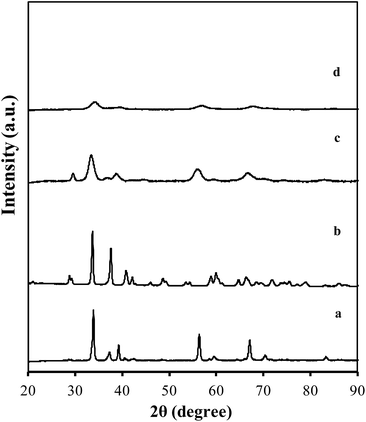 | ||
| Fig. 2 XRD patterns of catalysts (a) CeO2–ZrO2, (b) Au/ZrO2, (c) Au/CeO2–ZrO2–TiO2 and (d) Au/CeO2–ZrO2. | ||
H2 consumption during the samples reduction had been investigated by TPR studies. Fig. 3 shows H2-TPR profiles for CeO2–ZrO2 support and for Au/ZrO2, Au/CeO2–ZrO2 and Au/CeO2–ZrO2–TiO2 catalysts.
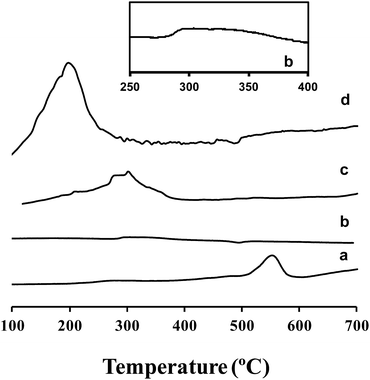 | ||
| Fig. 3 TPR profiles for (a) CeO2–ZrO2, (b) Au/ZrO2, (c) Au/CeO2–ZrO2–TiO2 and (d) Au/CeO2–ZrO2 catalysts. | ||
(i) The TPR spectrum of CeO2–ZrO2 support (Fig. 3a) has only one reduction peak at 552 °C that represents the reduction of the CeO2 surface oxygen.
(ii) In the TPR spectrum of Au/ZrO2 catalyst (Fig. 3b) a very broad and low intensity reduction peak was registered between 295 to 370 °C. This peak might be attributed to the reduction of oxygen species' surrounding the gold nanoparticles.
(iii) In the TPR spectrum of Au/CeO2–ZrO2 catalyst (Fig. 3d) one complex reduction peak was observed with maximum at temperature of 184.2 °C, formed by overlapping of several peaks. The origin of this spectrum can be connected with gold particles reduction process. It is well known that the small metal particles are reduced at lower-temperatures than the larger particles.12 Therefore, the overlapping peaks represent the consecutive reduction of narrow groups of gold particles with nearly equal average particles size. This is also an indication that average particles size of gold particles has narrow distribution.
(iv) In the TPR spectrum of Au/CeO2–ZrO2–TiO2 sample (Fig. 3c), similar reduction behaviour is observed. The gold particles reduction peaks are shifted slightly toward higher temperatures. This is indication that average gold particles in Au/CeO2–ZrO2 are smaller than in the Au/CeO2–ZrO2–TiO2 catalyst.
The presence of Au strongly depresses the reducibility of the catalyst's oxide support. The reduction peak detected in TPR spectrum of CeO2–ZrO2 sample at 552 °C was not detected in the TPR spectra of Au containing samples. This means that presence of gold in the catalyst composition is strongly depressing the oxygen mobility in CeO2–ZrO2 and CeO2–ZrO2–TiO2 mixed oxide systems. Therefore, the reducibility of Au containing oxide systems under study is determined by the properties of the supported Au particles.
High H2 consumption peak can be attributed to the better reducibility, and resulting better redox properties as well as better thermal stability of the catalyst.10 After depositing gold, it strongly interacts with the support, thus changing the reducibility of the support. The amount of hydrogen consumption in each of the studied catalysts decreased in the following order: Au/CeO2–ZrO2 > Au/CeO2–ZrO2–TiO2 > CeO2–ZrO2 > Au/ZrO2. The activity trend also follow the same order as discussed later on.
XPS measurements were used to identify the oxidation state of the Au species on different supports (Fig. 4). All gold containing samples showed two peaks, due to Au 4f5/2 and Au 4f7/2 signals. Metallic gold presence was registered at binding energy 83.64 eV and at 87.34 eV. These signals are result of the occurrence of Au 4f7/2 and Au 4f5/2 transitions. The peaks registered at binding energy of 85.27 eV and 88.97 eV respectively, which are result of the presence of Au+1 species. No Au+3 species were detected in the all gold containing samples. Deconvoluted spectrum of Au/ZrO2 catalyst showed about 16% of Au+1 species and 84% of metallic gold Au0 on the catalyst surface. For the Au/CeO2–ZrO2 sample, the metallic Au0 and oxidized gold percentages are almost the same, 47% of Au+1 and 53% of metallic gold Au0 on the surface. 31% of oxidized to Au+1 gold and 69% of metallic gold are found on Au/CeO2–ZrO2–TiO2 catalysts surface. Oxidized Au+1 species percentage on the surface of studied gold catalysts were decreasing in the following order: Au/CeO2–ZrO2 (47%) > Au/CeO2–ZrO2–TiO2 (31%) > Au/ZrO2 (16%). This order has similar trend with the amount of H2 consumption by these three catalysts and also in their catalytic activities.
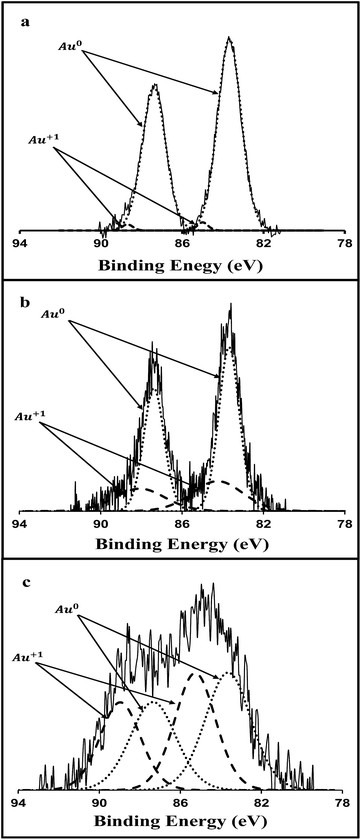 | ||
| Fig. 4 De-convoluted XPS spectra of Au 4f region for (a) Au/ZrO2, (b) Au/CeO2–ZrO2–TiO2 and (c) Au/CeO2–ZrO2 catalysts. | ||
Catalyst activity performance
The catalytic activity and product selectivity data of partial oxidation of methanol (POM) over three gold containing catalysts Au/ZrO2, Au/CeO2–ZrO2 and Au/CeO2–TiO2–ZrO2 and on the CeO2–ZrO2 support are presented in supplementary Table (S1)† and also depicted in Fig. 5. H2 and CO2 were the main reaction products, H2O and CO were by-products for the all the catalysts tested in this study. Only trace amounts of formaldehyde were observed on CeO2–ZrO2 support in all used temperatures. Fig. 5 shows catalytic activity results for POM on the CeO2–ZrO2 support and on the Au/ZrO2, Au/CeO2–ZrO2 and Au/CeO2–TiO2–ZrO2 catalysts at different temperatures.The catalytic activity for oxygen and methanol conversion and product selectivity of Au–ZrO2 and on CeO2–ZrO2 support are very low compared to the same parameters of the Au/CeO2–ZrO2 and Au/CeO2–TiO2–ZrO2 catalysts at the temperature range used in this study. O2 conversion reaches over 99% at a relatively low temperature (275 °C) for both of the Au/CeO2–ZrO2 and Au/CeO2–TiO2–ZrO2 catalysts, also showed high activity towards the methanol conversion. The activity of the tested Au catalysts increased with the increase of temperature and reaches values around 99% at 450 °C on both catalysts. Nearly 50% of methanol conversion and 31.6% of H2 selectivity were registered at temperature 275 °C for Au/CeO2–ZrO2 catalyst. The selectivity of H2 increased with the increase of the temperature and reached maximal value of 75.8% at 375 °C. Increasing of the CO selectivity with increase of the temperature was also observed and it reached maximum of 62.2% at temperature 450 °C. The Au/CeO2–TiO2–ZrO2 catalyst showed lowest H2 selectivity of 6.0% at temperature of 275 °C. It also was increased with the rise of temperature and reached value of 71.0% of at 425 °C. Relatively lower H2 selectivity was achieved at higher temperature compared to Au/CeO2–ZrO2 catalyst. Further increasing of the temperature leads to decrease of the selectivity to H2 and increase CO selectivity. CO selectivity of this catalyst is very low at temperatures below of 350 °C. Above this temperature the CO selectivity jumps to a higher value of 13%. The selectivity increases with the increase of temperature up to 450 °C with an end value of 57%. There is no decrease on CO selectivity after 375 °C as it was seen for H2 selectivity trend over Au/CeO2–ZrO2 catalyst, and above 425 °C for Au/CeO2–TiO2–ZrO2 catalyst. It is the indication that the reverse WGSR takes place above these temperatures over these particular catalysts.
Discussion
The POM process proceeds simultaneously with different parallel reactions at different temperature ranges. At low temperatures there may be combination of the complete combustion (4) in the presence of excess oxygen followed by the methanol steam reforming reaction (5) to produce hydrogen:| CH3OH + 1.5O2 → CO2 + 2H2O complete combustion | (4) |
| CH3OH + H2O → CO2 + 3H2 steam reforming | (5) |
As temperature is increased the methanol decomposition (6) is increased and WGSR (7) starts to proceeds. The result is that we observe increase in hydrogen selectivity in our system
| CH3OH → CO + H2 methanol decomposition | (6) |
| CO + H2O → CO2 + H2 water gas shift reaction | (7) |
At higher temperatures both methanol, oxygen are diminished from the system, therefore reverse water gas shift reaction starts to proceed. This explains the decrease in hydrogen selectivity at high temperatures (>400 °C). Moreover at low temperatures of (<325 °C) the low selectivity of hydrogen suggests that surface oxidation of hydrogen to water proceeds more selectively over these catalysts than the CO oxidation reaction according to CO2 concentration data. Some activity and selectivity data found in the published papers regarding Au based catalyst for POM reaction have been tabulated in Table 2 in order to compare with the results of our best performed catalyst. According to the literature Au/CeO2 (ref. 14) and Au/TiO2 (ref. 15) catalysts didn't show higher selectivity towards hydrogen, compared to our best performed catalyst, Au/CeO2–ZrO2, where we have attained 75.5% of hydrogen selectivity at 375 °C. For Au/TiO2 catalyst, zero CO formation and 35% of H2 selectivity at 310 °C was attained when oxygen to methanol ratio was controlled at 0.3, but disadvantage of this catalyst is that it was deactivated very soon.15 For other Au/CeO2 catalyst CO selectivity values were not reported and also it is observed relatively lower H2 selectivity at high temperature.14 At low temperature (275 °C) Au/CeO2–ZrO2 catalyst gave 7.5% of CO selectivity with 31.60% of H2 selectivity, and at high temperature it exhibits better hydrogen selectivity and methanol conversion. In ref. 16 it is reported that the best catalyst have 84% selectivity for H2 and about 20% selectivity for CO with 98% methanol conversion. However, these authors used another precious metal Ru in addition to Au.
| Catalyst | T (°C) | O2![[thin space (1/6-em)]](https://www.rsc.org/images/entities/char_2009.gif) : :![[thin space (1/6-em)]](https://www.rsc.org/images/entities/char_2009.gif) CH3OH mole ratio CH3OH mole ratio |
CH3OH conversion (%) | H2 selectivity (%) | CO selectivity (%) | Ref. |
|---|---|---|---|---|---|---|
| Au–Ru/Fe2O3 | 250 | 0.3 | 98.0 | 84 | 20 | 16 |
| Au/TiO2 | 250 | 0.3 | 80.0 | 35 | 15 | 15 |
| Au/CeO2 | 250 | 0.3 | 75.0 | 12 | N/A | 14 |
| Au/ZrO2 | 450 | 0.5 | 66.0 | 16.0 | 68.24 | This work |
| Au/CeO2–ZrO2 | 375 | 0.5 | 91.6 | 75.5 | 22.30 | This work |
| Au/CeO2–ZrO2–TiO2 | 425 | 0.5 | 99.2 | 70.6 | 44.96 | This work |
The present study shows that Au/CeO2–ZrO2 catalyst has the highest catalytic activity for production H2 among the tested four catalysts. The catalytic performance of these catalysts are arranged in the following decreasing order Au/CeO2–ZrO2 > Au/CeO2–ZrO2–TiO2 > CeO2–ZrO2 > Au/ZrO2. From TPR result we can see that after deposition of gold on the oxide supports, the catalysts have significantly lower the reduction temperature compared to the corresponding pure supports. Therefore, gold is playing the key role for changing the redox property of the Au containing catalysts. BET, XRD, TPR and XPS results indicate that the higher is the surface area, of gold dispersed on the surface, the higher are redox property of support and the higher is the amount of the Au+1 species of gold. It is the main factor influencing the catalytic performance of gold supported catalysts. Among the tested catalysts, Au/ZrO2 has the lowest activity in POM because of the largest part of the surface gold atoms are in Au0 state. This is result of Au interaction with ZrO2 support. On the other hand, in Au/CeO2–ZrO2 metallic Au0 and Au+1 species are detected and surface presence of these two states of gold are in equal amounts. Therefore, it has the content of Au+1 species relatively higher than in the other samples and for this reason it shows the best catalytic activity and hydrogen selectivity for POM reaction. Fig. 6 depicts a relationship that describes the influence of Au1+ content on the catalyst surface on hydrogen selectivity at 400 °C.
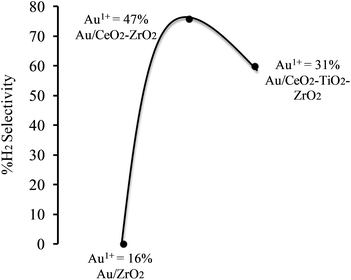 | ||
Fig. 6 Relation between Au+1 content (XPS) over different supports and hydrogen selectivity for partial oxidation of methanol at 375 °C, O2![[thin space (1/6-em)]](https://www.rsc.org/images/entities/char_2009.gif) : :![[thin space (1/6-em)]](https://www.rsc.org/images/entities/char_2009.gif) CH3OH molar feed ratio 0.5 and GHSV = 30 CH3OH molar feed ratio 0.5 and GHSV = 30![[thin space (1/6-em)]](https://www.rsc.org/images/entities/char_2009.gif) 000 h−1. 000 h−1. | ||
As it is noticed, with the increase of the Au1+ content on the catalyst surface, the selectivity of H2 increases (Fig. 6). Obviously, the amount of oxidized gold species in the catalyst is playing important role in the POM process. Therefore all described above reactions i.e. methanol combustion, partial oxidation, steam reforming, reverse water gas shift and hydrogen combustion are taking place simultaneously. Decreasing the yield of hydrogen at higher temperature might be result of the proceeding of the reverse WGSR. Further research need to be conducted for studying in details the catalyst calcinations regime pre-treatment procedure, as well as the catalyst promotion by other elements.
Conclusions
Au/CeO2–ZrO2 catalyst showed the best catalytic activity and H2 selectivity for methanol partial oxidation among the investigated catalysts. The catalytic activity decreased in the following sequence Au/CeO2–ZrO2 > Au/CeO2–ZrO2–TiO2 > CeO2–ZrO2 > Au/ZrO2.The same trend was observed in the catalysts reducibility and in percentage of Au+1 content in the catalysts. At optimal temperature of 375 °C we have observed 91.6% of methanol conversion, 75.5% of H2 selectivity and 22.3% of CO selectivity for Au/CeO2–ZrO2 catalyst. Deposition of gold on CeO2–ZrO2 mixed oxide support strongly depresses its partial reduction and oxygen mobility.
Acknowledgements
The support of Deanship of Graduate Studies at King Abdulaziz University for the Postgraduate Scholarship for International Students is highly appreciated. The authors also would like to acknowledge the financial and technical support from the SABIC Chair of Catalysis, King Abdulaziz University.References
- B. Hereijgers and B. Weckhuysen, ChemSusChem, 2009, 2, 743 CrossRef CAS PubMed.
- M. Haruta, J. Catal., 1989, 115, 301 CrossRef CAS.
- M. Haruta, S. Tsubota, T. Kobayashi, H. Kageyama, M. J. Genet and B. Dalmon, J. Catal., 1993, 144, 175 CrossRef CAS.
- H. Kung, J. Catal., 2003, 216, 425 CrossRef CAS.
- A. Gluhoi, N. Bogdanchikova and B. Nieuwenhuys, J. Catal., 2005, 229, 154 CrossRef CAS.
- Y.-J. Huang, K. L. Ng and H.-Y. Huang, Int. J. Hydrogen Energy, 2011, 36, 15203 CrossRef CAS.
- F.-W. Chang, T.-C. Ou, L. S. Roselin, W.-S. Chen, S.-C. Lai and H.-M. Wu, J. Mol. Catal. A: Chem., 2009, 313, 55 CrossRef CAS.
- M. M. Schubert, S. Hackenberg, A. C. van Veen, M. Muhler, V. Plzak and R. J. Behm, J. Catal., 2001, 197, 113 CrossRef CAS.
- D. Srinivas, C. V. V. Satyanarayana, H. S. Potdar and P. Ratnasamy, Appl. Catal., A, 2003, 246, 323 CrossRef CAS.
- C. Pojanavaraphan, A. Luengnaruemitchai and E. Gulari, Int. J. Hydrogen Energy, 2013, 38, 1348 CrossRef CAS.
- N. Srisiriwat, S. Therdthianwong and A. Therdthianwong, Int. J. Hydrogen Energy, 2009, 34, 2224 CrossRef CAS.
- C. Pojanavaraphan, A. Luengnaruemitchai and E. Gulari, Appl. Catal., A, 2013, 456, 135 CrossRef CAS.
- C. Chang, Y. Chen and C. Yeh, Appl. Catal., A, 1998, 174, 13 CrossRef CAS.
- Q. Chena, L. Luoa and X. Yangb, Indian J. Chem., 2008, 47, 1317 Search PubMed.
- F.-W. Chang, H.-Y. Yu, L. Selva Roselin and H.-C. Yang, Appl. Catal., A, 2005, 290, 138 CrossRef CAS.
- F.-W. Chang, L. S. Roselin and T.-C. Ou, Appl. Catal., A, 2008, 334, 147 CrossRef CAS.
Footnote |
| † Electronic supplementary information (ESI) available. See DOI: 10.1039/c5ra24025e |
| This journal is © The Royal Society of Chemistry 2016 |

